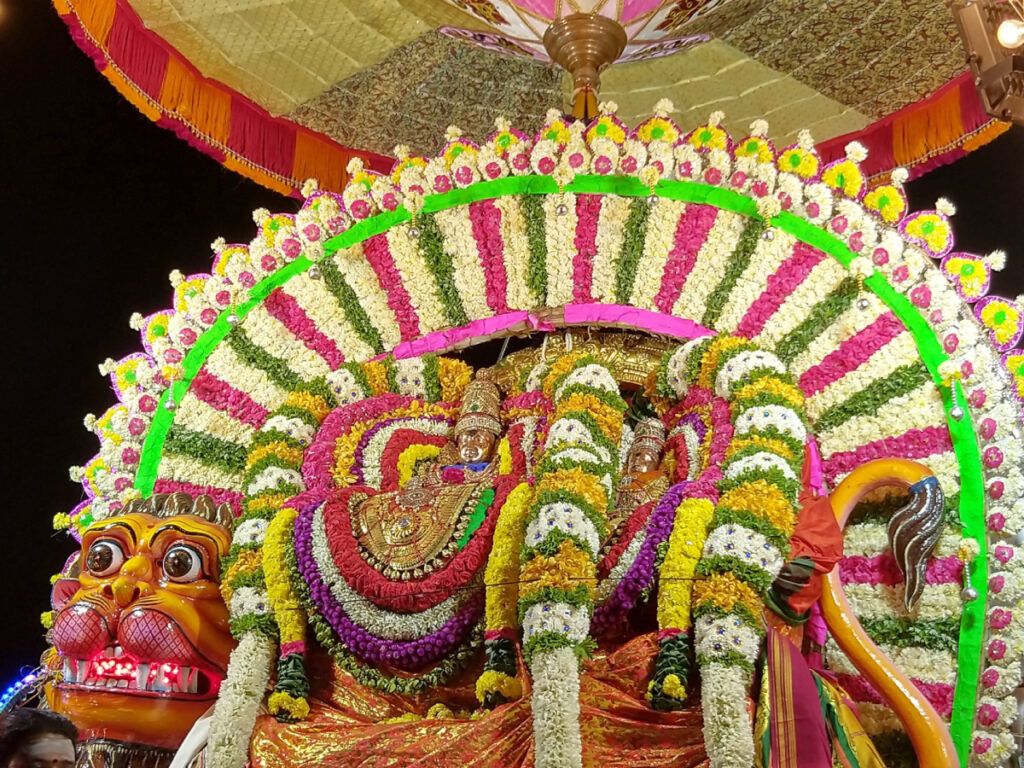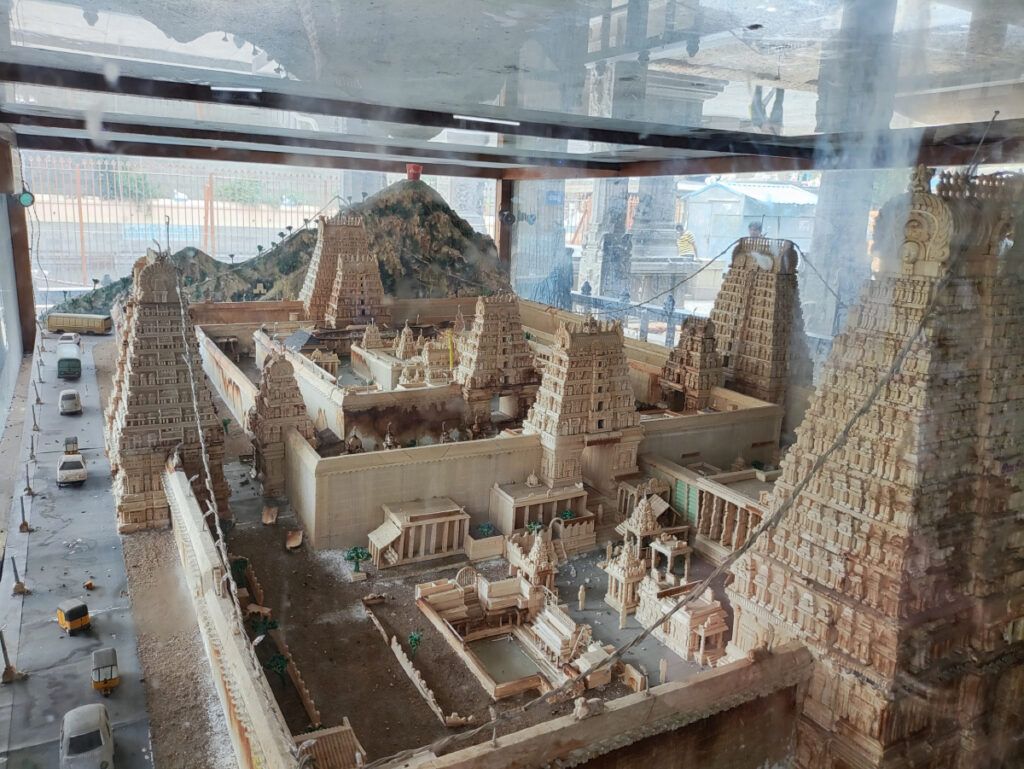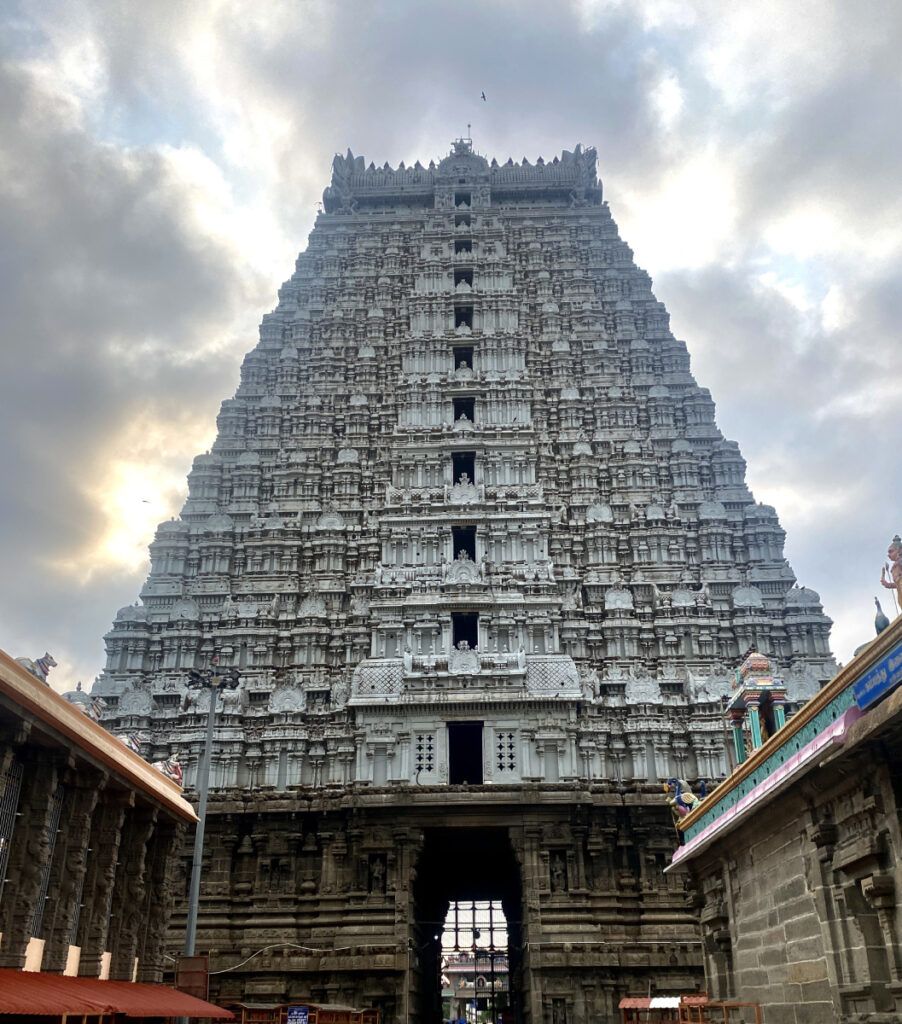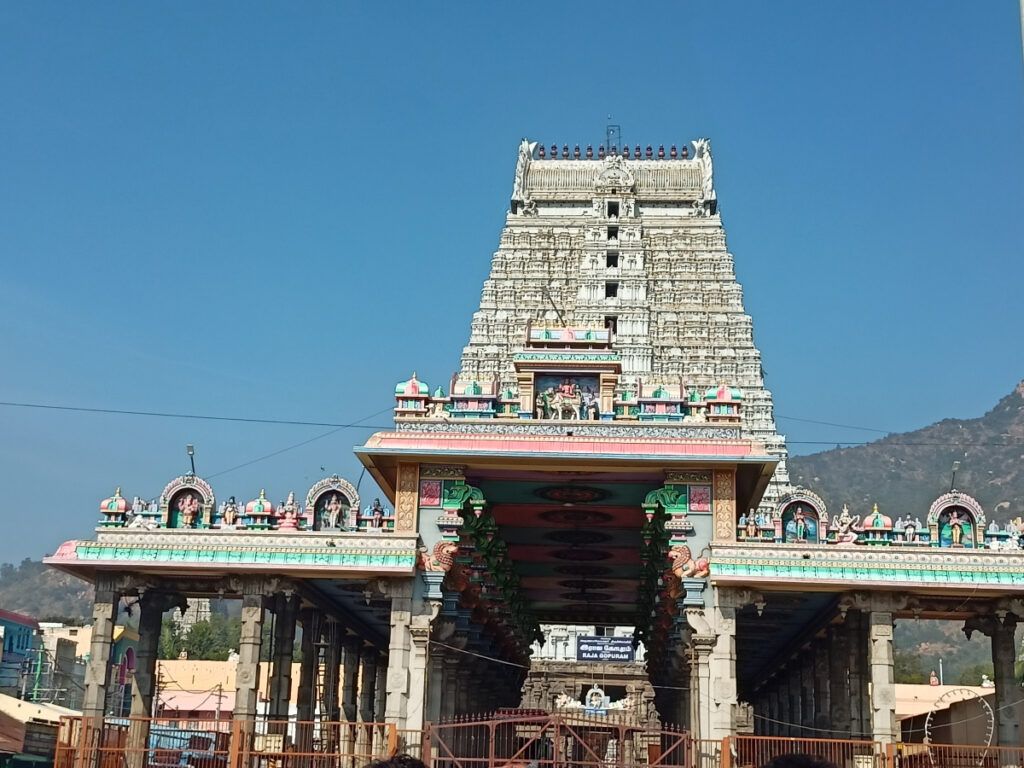Arunachaleswara Temple: 3rd Agni Lingam
Arunachaleswara Temple (also known as Annamalaiyar Temple) is a Hindu temple dedicated to the deity Shiva, located at the base of Arunachala hill in the town of Tiruvannamalai in Tamil Nadu, India. It is significant to the Hindu sect of Shaivism as one of the temples associated with the five elements, the Pancha Bhuta Sthalams, and specifically the element of fire, or Agni.

The temple complex is one of the largest in India, covering an area of over 25 acres. It has four gateway towers known as gopurams, the tallest of which is the eastern tower, which stands at a height of 66 meters. The temple complex also houses numerous shrines, including the main shrine of Arunachaleswara and his consort Unnamalai Amman.
The Arunachaleswara Temple is a popular pilgrimage site for Hindus from all over India and the world. It is especially popular during the Karthigai Deepam festival, which is celebrated in November-December. During this festival, a massive bonfire is lit at the top of Arunachala hill, which can be seen from miles away.
The Arunachaleswara Temple is also a place of spiritual significance for many people of different faiths. It is said that the temple is located at the heart chakra of the Earth, and that it is a place where people can come to experience deep spiritual transformation.
Here is a quote from the Tamil poet and saint Manikkavasagar, who wrote about the Arunachaleswara Temple in the 9th century:
“Arunachala, the Hill of Fire, Where Shiva dances as the eternal flame, Is the heart of the universe, The source of all creation and destruction. Those who go to Arunachala, And meditate on its sacred form, Will be freed from the cycle of birth and death, And attain eternal bliss.”
Read More>> Brihadeeswarar Temple: Timeless Marvel of Chola Architecture

Contents
- 1 History of Arunachaleswara Temple:
- 2 Legend of Arunachaleswara Temple:
- 3 Architecture of Arunachaleswara Temple:
- 4 Specialty of Arunachaleswara Temple:
- 5 Arunachaleswara Temple Timing:
- 6 Places to visit near Arunachaleswara Temple:
- 7 FAQ:
- 7.0.1 Where is Arunachaleswara Temple located?
- 7.0.2 Who is the main deity of the Arunachaleswara Temple?
- 7.0.3 What is the significance of the Arunachala Hill near the temple?
- 7.0.4 When are the major festivals celebrated at Arunachaleswara Temple?
- 7.0.5 What is the significance of the Deepam festival?
- 7.0.6 Can non-Hindus visit the temple?
- 7.0.7 Is there a specific dress code for visitors to the temple?
- 7.0.8 Are there any special rituals or practices associated with the temple?
- 7.0.9 Is photography allowed within the temple complex?
- 8 How to reach Arunachaleswara Temple?
- 9 Google Maps:
History of Arunachaleswara Temple:
The history of the Arunachaleswara Temple is ancient and obscure. There is no definitive record of when the temple was first built, but it is believed to be one of the oldest temples in India. The earliest known inscriptions in the temple date back to the 9th century CE, but there is evidence that the temple was already in existence centuries before that.
The Arunachaleswara Temple has been patronized by many different dynasties over the centuries, including the Pallavas, Cholas, Vijayanagaras, and Nayaks. Each of these dynasties made significant contributions to the temple, adding new structures and expanding the temple complex.
The temple is also associated with many Hindu saints and sages, including the Nayanmars and the Alvars. These saints wrote extensively about the Arunachaleswara Temple, praising its beauty and its spiritual significance.
In recent centuries, the Arunachaleswara Temple has become a popular tourist destination. People from all over the world come to visit the temple and to experience its unique spiritual atmosphere.
Here are some of the key events in the history of the Arunachaleswara Temple:
- 9th century CE: The earliest known inscriptions in the temple date back to this time.
- 11th century CE: The Chola dynasty builds the Rajagopuram, the eastern gateway tower of the temple.
- 13th century CE: The Vijayanagara dynasty begins to patronize the temple.
- 16th century CE: The Nayak dynasty builds the Thirumanjangopuram, the southern gateway tower of the temple.
- 19th century CE: The British colonial government takes control of the temple administration.
- 20th century CE: The Arunachaleswara Temple becomes a popular tourist destination.
Read More>> Vijayawada Kanaka Durga Temple: A Beacon of Hope & Strength

Legend of Arunachaleswara Temple:
The legend of Arunachaleswara Temple is one of the most popular and well-known in Hinduism. It tells the story of how Shiva manifested himself as a column of fire, and challenged the gods Brahma and Vishnu to find his source.
According to the legend, Brahma and Vishnu once began to argue over who was the superior god. To settle their argument, they went to Shiva and asked him to judge. Shiva then transformed into a massive column of fire, whose crown and feet could not be found by either Brahma or Vishnu.
Brahma took the form of a swan and flew to the top of the column, but he could not find its end. Vishnu became the boar Varaha and burrowed into the earth to find the base of the column, but he was also unsuccessful.
After many years, Brahma and Vishnu finally admitted defeat. They realized that Shiva was the supreme god, and that he was beyond their comprehension.
The column of fire then transformed back into Shiva, and he revealed that he had manifested himself in Arunachaleswara Temple. Shiva told Brahma and Vishnu that Arunachaleswara Temple was the holiest place on Earth, and that anyone who came there to worship him would be liberated from the cycle of birth and rebirth.
The legend of Arunachaleswara Temple is a reminder of Shiva’s supreme power and divinity. It is also a reminder that Arunachaleswara Temple is a sacred place where people can come to experience Shiva’s grace and blessings.
Read More>> Enchanting Beauty of Madurai Meenakshi Amman Temple
Here is another version of the legend:
One day, the goddess Parvati closed Shiva’s eyes in a playful gesture. The world was plunged into darkness, and all creation was threatened. Shiva then opened his third eye, which is a powerful source of light and energy. The light from Shiva’s third eye was so intense that it burned away the darkness and restored light to the world.
However, the light from Shiva’s third eye was so powerful that it also threatened to destroy the world. To prevent this, Shiva manifested himself as a column of fire at Arunachaleswara Temple. The fire then cooled and transformed into a lingam, which is a symbolic representation of Shiva.
The lingam at Arunachaleswara Temple is said to be the most powerful lingam in the world. It is said that anyone who worships the lingam at Arunachalam Temple will be liberated from the cycle of birth and rebirth.

Architecture of Arunachaleswara Temple:
The Arunachaleswara Temple is renowned for its stunning Dravidian-style architecture. Here are some of the key architectural features of the temple:
Gopurams: The temple is adorned with several towering gopurams (ornate entrance towers). The four main gopurams are located on the four cardinal directions, and they are intricately carved with various sculptures and deities. These gopurams are known for their grandeur and intricate details.
Prakarams: The temple has multiple prakarams (enclosures) that lead to the inner sanctum. Each prakaram is lined with pillars, and some have smaller shrines and mandapams (halls) dedicated to various deities.
Vimana: The main sanctum of the temple, where the lingam of Lord Arunachaleswara is enshrined, is situated within a vimana (tower) known as the Rajagopuram. The vimana is an impressive structure that soars above the inner sanctum.
Stone Carvings: The temple is known for its intricate stone carvings that depict various episodes from Hindu mythology, deities, and intricate patterns. These carvings are seen on the gopurams, pillars, walls, and ceilings.
Mandapams: The temple complex includes numerous mandapams or halls, each with unique architectural styles. Some of the prominent mandapams are the Thousand Pillar Hall and the Raja Gopuram Mandapam, both showcasing exquisite stone carvings.
Tank and Temple Kitchen: The temple complex also houses a large temple tank, known as the Sivaganga Tank, which serves both ritual and practical purposes. There is also a temple kitchen (Annadhana Mandapam) where free meals are offered to devotees.
Prakara Walls: The temple is enclosed by massive prakara walls that are adorned with intricate sculptures and carvings. These walls separate the inner temple complex from the outer areas.
Arunachala Hill: While not a part of the temple’s architectural structure, the sacred Arunachala Hill itself is considered an integral part of the temple’s spiritual significance. Devotees often circumambulate the hill as a form of worship.
Read More>> Saptashrungi Bhadrakali Temple Nasik

Specialty of Arunachaleswara Temple:
The temple is believed to be one of the oldest in India, with some sources dating its construction back to the 5th millennium BCE. It has been expanded and renovated over the centuries by various dynasties, and now stands as a sprawling complex covering over 10 hectares. The temple complex includes four gateway towers, numerous shrines, and two tanks.
Arunachaleswara Temple is famous for its many unique features. One of the most significant is the Agni Lingam, the main deity of the temple. The Agni Lingam is a massive lingam (aniconic representation of Shiva) that is said to be self-manifested. It is also said that the lingam is constantly growing, and that it will eventually fill the entire temple complex.
Another unique feature of Arunachalam Temple is the Arunachala hill itself. The hill is considered to be a sacred manifestation of Shiva, and many devotees circumambulate the hill (known as Girivalam) as a form of worship. Girivalam is said to be a very powerful spiritual practice, and it is believed that circumambulating the hill 14 times is equivalent to visiting all of the other Shiva temples in the world.
Arunachalam Temple is also famous for its Karthigai Deepam festival, which is celebrated every year during the Karthigai month (November-December). During the festival, a massive lamp is lit on top of the Arunachala hill. The lamp can be seen from miles away, and it is a truly spectacular sight.
Arunachaleswara Temple Timing:
- Morning Timings:
- 5:30 AM to 9:00 AM: Morning Darshan and Pooja
- 9:00 AM to 9:45 AM: Uchikala Pooja
- 10:30 AM to 11:30 AM: Sayaratchai Pooja
- Evening Timings:
- 4:00 PM to 4:45 PM: Pradosha Pooja
- 5:30 PM to 6:30 PM: Evening Darshan and Pooja
- 8:00 PM to 8:45 PM: Arthajama Pooja
Read More>> Shakti Bhavani at Chandranath Temple Sitakunda Bangladesh

Places to visit near Arunachaleswara Temple:
Thiruvannamalai, where the Arunachaleswara Temple is located, is a town rich in culture and spirituality. There are several interesting places to visit near the Arunachaleswara Temple, both within the town and in its vicinity. Here are some notable ones:
Sri Ramana Ashram: This ashram is dedicated to the teachings of Sri Ramana Maharshi, a renowned sage. It’s a place of meditation and self-inquiry and is located in the heart of Thiruvannamalai.
Seshadri Swamigal Ashram: Another ashram in the town dedicated to the teachings of a spiritual leader. It’s known for its peaceful atmosphere and is open to visitors seeking spiritual solace.
Arunachala Hill: As mentioned earlier, circumambulating the Arunachala Hill is a significant spiritual activity. The path around the hill is about 14 kilometers and is considered a sacred journey.
Skandashramam: A cave where Sri Ramana Maharshi lived for several years. It’s a place of spiritual significance and offers a serene environment for meditation.
Sri Ramanasramam Library: If you’re interested in the teachings and writings of Sri Ramana Maharshi, this library is a valuable resource.
Virupaksha Cave: This cave is associated with Sri Ramana Maharshi, who lived there for some time. It’s a peaceful spot for meditation and reflection.
Yogi Ram Surat Kumar Ashram: This ashram is dedicated to Yogi Ram Surat Kumar, a spiritual teacher who lived in the 20th century. It’s a place of meditation and contemplation.
Gingee Fort: Located about 30 kilometers from Thiruvannamalai, Gingee Fort is a historical site with impressive architecture. It’s known for its three hilltop citadels and is often referred to as the “Troy of the East.”
Thiruvannamalai Deepam Festival: If you visit during the Deepam Festival, you can witness the lighting of the huge lamp on Arunachala Hill, which is a spectacular and spiritually significant event.
Sathanur Dam: Situated around 30 kilometers from Thiruvannamalai, this dam is a popular spot for picnics and boating.
Yoga and Meditation Centers: Thiruvannamalai is known for its numerous yoga and meditation centers, making it an excellent place to learn and practice these disciplines.
Local Temples: Explore other smaller temples in the area, which often have their own unique stories and architectural beauty.
Read More>> Grishneshwar Temple: Wealth and Pleasure at Shiva’s Feet
FAQ:
Where is Arunachaleswara Temple located?
The Arunachaleswara Temple is located in the town of Thiruvannamalai in the state of Tamil Nadu, India.
Who is the main deity of the Arunachaleswara Temple?
The primary deity of the temple is Lord Arunachaleswara, a form of Lord Shiva.
What is the significance of the Arunachala Hill near the temple?
Arunachala Hill, also known as Annamalai Hill, is believed to be a physical embodiment of Lord Shiva and is considered sacred. Devotees often perform circumambulation (Girivalam) around this hill as a form of worship.
When are the major festivals celebrated at Arunachaleswara Temple?
The temple hosts several festivals throughout the year. The most famous one is the Annamalai Deepam festival, celebrated during the full moon in the Tamil month of Kartikai (November-December).
What is the significance of the Deepam festival?
The Annamalai Deepam festival involves lighting a massive lamp on top of Arunachala Hill, and it is considered highly auspicious. It is believed to symbolize the manifestation of Lord Shiva as a column of fire.
Can non-Hindus visit the temple?
Yes, non-Hindus are typically allowed to visit the temple. However, it’s important to show respect for the customs and traditions of the temple and dress modestly.
Is there a specific dress code for visitors to the temple?
It’s recommended to wear traditional and modest clothing when visiting the temple. It’s common for men to wear dhotis and women to wear sarees or appropriate attire that covers their shoulders and knees.
Are there any special rituals or practices associated with the temple?
One of the unique practices at the temple is Girivalam, where devotees walk around Arunachala Hill as a form of worship and pilgrimage. Additionally, many devotees engage in meditation and prayer within the temple premises.
Is photography allowed within the temple complex?
Photography policies may vary, so it’s advisable to check with the temple authorities for the most current rules regarding photography and the use of electronic devices.
How to reach Arunachaleswara Temple?
By Air:
The nearest major airport is Chennai International Airport (MAA), located approximately 185 kilometers (115 miles) away from Thiruvannamalai. You can book a flight to Chennai and then take a taxi or bus to Thiruvannamalai.
By Train:
Thiruvannamalai has its railway station, Tiruvannamalai Railway Station. You can check for train services to this station from various parts of India.
By Road:
If you’re traveling by road, you can use buses, taxis, or your private vehicle. Thiruvannamalai is well-connected to major cities and towns in Tamil Nadu and other nearby states. The town is situated on National Highway 66 (NH66), making it accessible by road.
Here’s how you can reach Thiruvannamalai by road from some major cities:
From Chennai: Thiruvannamalai is approximately a 4-5 hour drive from Chennai. You can take NH66.
From Bangalore: Thiruvannamalai is about a 4-5 hour drive from Bangalore via NH75 and NH234.
From Pondicherry: It’s approximately a 3-4 hour drive from Pondicherry via NH234.
From Coimbatore: The distance is around 5-6 hours via NH181 and NH234.
From Vellore: Thiruvannamalai is about a 2-3 hour drive from Vellore via SH132.
Once you reach Thiruvannamalai town, the Arunachalam Temple is located at its center. You can easily access the temple by walking or taking a short auto-rickshaw or taxi ride from most parts of the town. The temple is a prominent landmark and is easily recognizable.

2 Comments